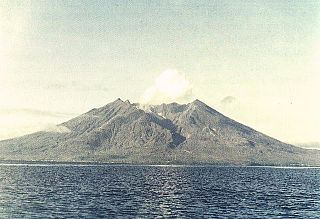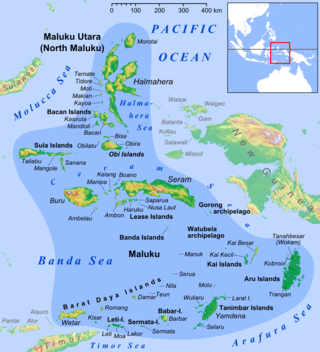Related Research Articles

Makian, known to local people as Mount Kie Besi, is a volcanic island, one of the Maluku Islands within the province of North Maluku in Indonesia. It lies near the southern end of a chain of volcanic islands off the western coast of the province's major island, Halmahera, and lies between the islands of Moti and Tidore to the north and Kayoa and the Bacan Group to the south. The island, which forms two districts within South Halmahera Regency of North Maluku Province, covers an area of 84.36 sq.km, and had a population of 12,394 at the 2010 Census, which rose to 14,000 at the 2020 Census. The official estimate as at mid 2023 was 12,525.

The Papuan languages are the non-Austronesian languages spoken on the western Pacific island of New Guinea, as well as neighbouring islands in Indonesia, Solomon Islands, and East Timor. It is a strictly geographical grouping, and does not imply a genetic relationship.
In addition to its classical and modern literary form, Malay had various regional dialects established after the rise of the Srivijaya empire in Sumatra, Indonesia. Also, Malay spread through interethnic contact and trade across the south East Asia Archipelago as far as the Philippines. That contact resulted in a lingua franca that was called Bazaar Malay or low Malay and in Malay Melayu Pasar. It is generally believed that Bazaar Malay was a pidgin, influenced by contact among Malay, Hokkien, Portuguese, and Dutch traders.
Taba is a Malayo-Polynesian language of the South Halmahera–West New Guinea group. It is spoken mostly on the islands of Makian, Kayoa and southern Halmahera in North Maluku province of Indonesia by about 20,000 people.

The West Papuan languages are a proposed language family of about two dozen non-Austronesian languages of the Bird's Head Peninsula of far western New Guinea, the island of Halmahera and its vicinity, spoken by about 220,000 people in all. It is not established if they constitute a proper linguistic family or an areal network of genetically unrelated families.
The Lower Mamberamo languages are a recently proposed language family linking two languages spoken along the northern coast of Papua province, Indonesia, near the mouth of the Mamberamo River. They have various been classified either as heavily Papuanized Austronesian languages belonging to the SHWNG branch, or as Papuan languages that had undergone heavy Austronesian influence. Glottolog 3.4 classifies Lower Mamberamo as Austronesian, while Donohue classifies it as Papuan. Kamholz (2014) classifies Warembori and Yoke each as coordinate primary subgroups of the South Halmahera–West New Guinea languages.

The South Halmahera–West New Guinea (SHWNG) languages are a branch of the Malayo-Polynesian languages, found in the islands and along the shores of the Halmahera Sea in the Indonesian province of North Maluku and of Cenderawasih Bay in the provinces of Papua and West Papua. There are 38 languages.
Tidore is a language of North Maluku, Indonesia, spoken by the Tidore people. The language is centered on the island of Tidore, but it is also spoken in some areas of the neighbouring Halmahera. Historically, it was the primary language of the Sultanate of Tidore, a major Moluccan Muslim state.
Andrew Kenneth Pawley, FRSNZ, FAHA, is Emeritus Professor at the School of Culture, History and Language of the College of Asia and the Pacific at the Australian National University.
The South Halmahera languages are the branch of Austronesian languages found along the southeast coast of the island of Halmahera in the Indonesian province of North Maluku. Irarutu is spoken in the east of the Bomberai Peninsula in West Papua province.
Ternate is a language of northern Maluku, eastern Indonesia. It is spoken by the Ternate people, who inhabit the island of Ternate, as well as many other areas of the archipelago. It is the dominant indigenous language of North Maluku, historically important as a regional lingua franca. A North Halmahera language, it is unlike most languages of Indonesia which belong to the Austronesian language family.
West Makian is a divergent North Halmahera language of Indonesia. It is spoken on the coast near Makian Island, and on the western half of that island.

The North Halmahera (NH) languages are a family of languages spoken in the northern and eastern parts of the island of Halmahera and some neighboring islands in Indonesia. The southwestern part of the island is occupied by the unrelated South Halmahera languages, which are a subgroup of Austronesian. They may be most closely related to the languages of the Bird's Head region of West Papua, but this is not well-established.
Tondano is an Austronesian language spoken in the Tondano area of northeast Sulawesi, Indonesia. It is most similar to Tombulu and to Tonsea.
Rongga is a language of central Flores, in East Nusa Tenggara Province, Indonesia. Rongga is closely related to Ngadha, and more distantly to Manggarai.
Gorap is a Malay-based creole language predominantly spoken by Gorap (Bobaneigo) ethnic group, indigenous to western and northern regions of the Indonesian island of Halmahera. It shares vocabulary with other Papuan languages and some of languages spoken in Sulawesi, such as Buginese and Cia-Cia. Roughly around 60 out of 200 attested words in this language were indicated sharing vocabulary with those languages.

Kayoa, or in the native language Pulau Urimatiti, is a group of 66 islands, part of the Maluku Islands. It is located in South Halmahera Regency, part of North Maluku Province of Indonesia.
Bacan Malay or Bacan is a Malayic language spoken on the island of Bacan in North Maluku province, Indonesia, by the minor Bacan ethnic group. It is an anomalous presence in the region, being surrounded by genetically distant Austronesian languages and languages of the unrelated North Halmahera family. Bacan is geographically removed from the Malay heartlands in the western archipelago.

Gabriella Hermon is an American linguist, professor emerita at the University of Delaware.
Marian Klamer is a linguist who specializes in Austronesian and Papuan languages. Her interests include the documentation of minority languages, Malay language varieties, linguistic typology, historical linguistics, and language contact.
References
- ↑ "55251925". viaf.org. Retrieved 15 January 2020.
- 1 2 "Introducing New Staff 42 :: ILCAA". www.aa.tufs.ac.jp. Retrieved 13 January 2020.
- ↑ Bowden, John (1997), Taba (Makian Dalam): Description of an Austronesian language from Eastern Indonesia, Melbourne: Department of Linguistics and Applied Linguistics, University of Melbourne, hdl:11343/35661, OCLC 222104670
- 1 2 3 Setiono Sugiharto (21 November 2012). "Frederick John Bowden: A passionate linguistic typologist". The Jakarta Post. Retrieved 13 January 2020.